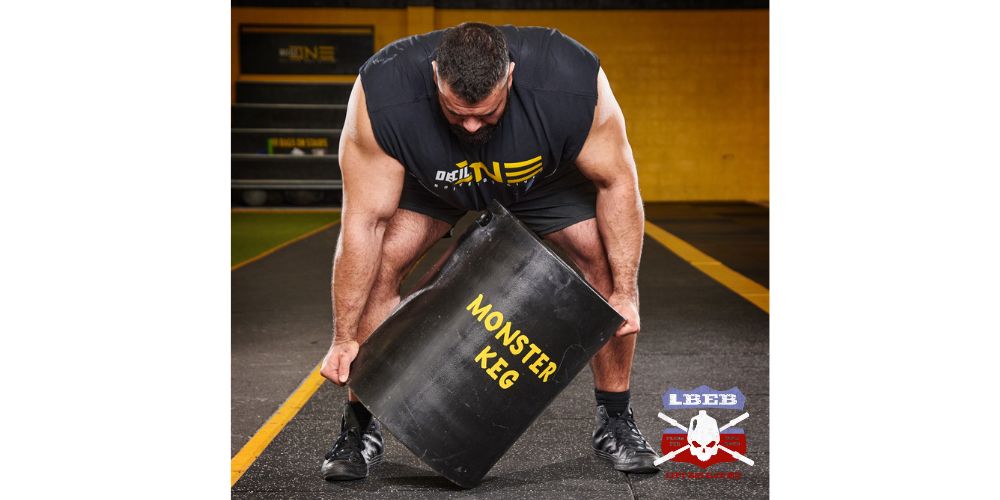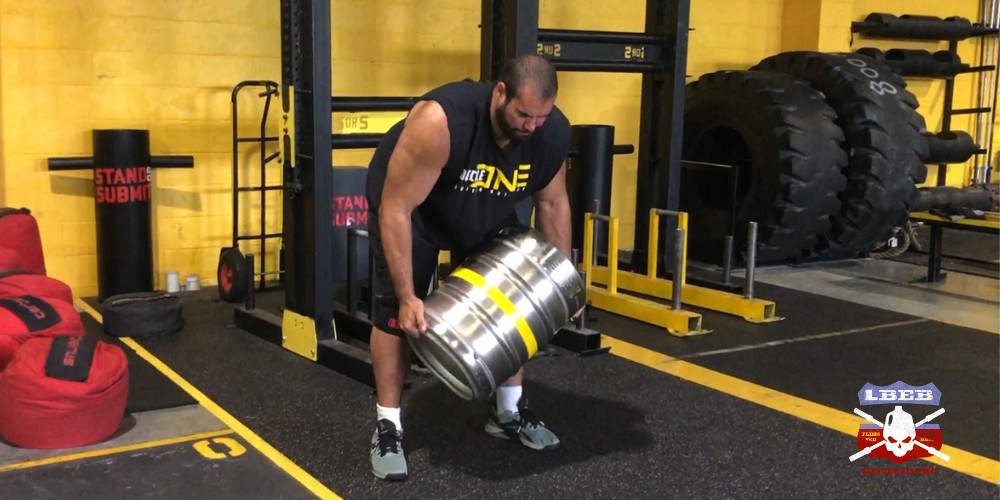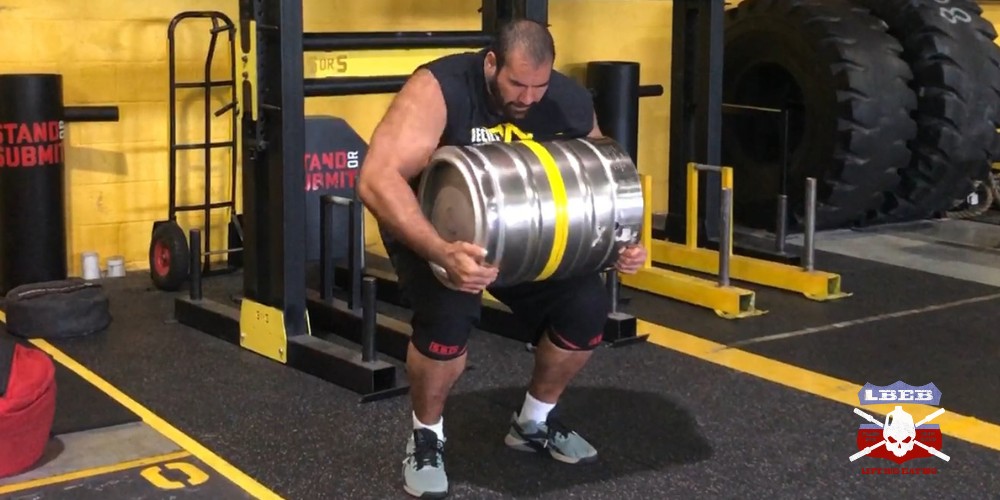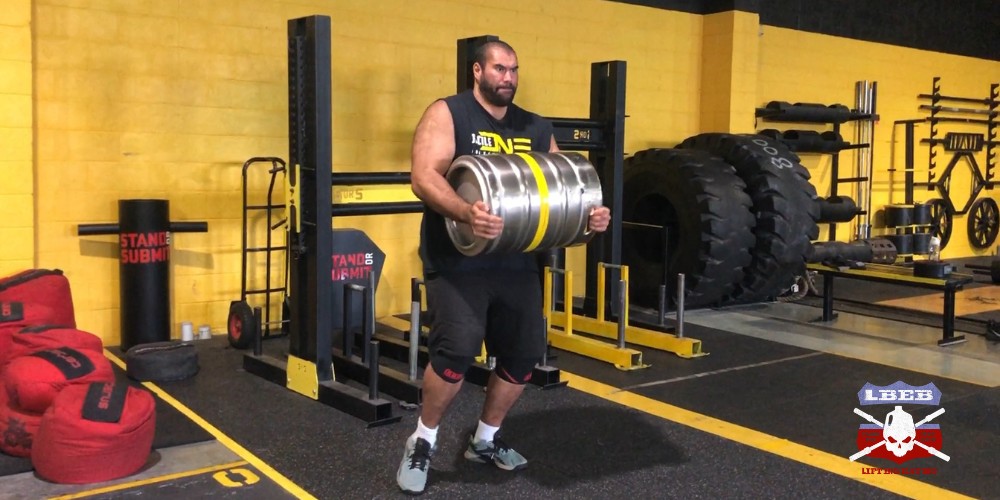While kegs may be most well known due to their ability to store alcohol and use in “keg parties,” they are also a fantastic tool to get bigger, stronger, and fitter. In the strongman realm, they used to improve front-carrying performance across a range of events.
While you will employ a similar technique to lift them as sandbags and other common strongman implements, the smooth surface and often unstable fillings of the keg lead to it being a unique test of carrying strength and ability.
Table of Contents
Keg Carry Technique
Step 1: Tip & Grip

Kegs always start upright in competition, so your first step will be tipping the keg to one side and gripping it. Personally, I like to have my dominant hand (right) grip the side of the closest side of the keg at the bottom, with my non-dominant hand on the far side of the keg holding the handle at the top.
Step 2: The Pickup


Now that you are in position, the next step is to pick the keg off the floor and get into the lap position. To execute the pickup, you want to think of it like a deadlift and drive the world away from you while simultaneously extending the hips (standing up).
A common mistake is pulling the keg off the floor with your arms. This is a recipe for injury, so unless you want to tear your biceps, use your lower body for the initial drive.
Once the keg has cleared your knees, you can use your arms to pull the keg close to your body and sit down into a squat position with the keg on your knees.
Step 3: Regrip & Stand


While in this lap position, you will want to squat low enough that the keg is pulled tight into your upper abs (similar to where you log clean from).
Then move your dominant arm to regrip the far side of the keg, continue to pull the keg close to you with this grip and simultaneously stand and drive your hips forward.
If you are competing, you will want to continue this momentum of standing to go straight into short quick steps. If the keg is lighter, you could take longer strides to cover distance quicker.
Quick Note
I have described to you the most beginner-friendly way to lift the keg. It is safe and in sequential steps allowing you to get stronger in the movement and more confident. However, you will note that athletes often throw the keg up from the floor to the lap position in a strongman competition.
This is a much better strategy for athletes who have been training for some time and are familiar with the load they will be using in competition.
You will save valuable time by picking up and gripping the keg either while it’s in the air or barely squatting down in the lap position, which is crucial as it’s most often seen as a speed event.
The other option you will sometimes see is athletes not regripping the keg to grip both far sides of the keg but rather keeping a staggered stance. This can also be a time-saving strategy if the kegs are lighter.
Shorter-armed or particularly barrel-chested competitors might also elect to do this technique, as gripping both arms to the far side leaves them overextended.
At the World’s Strongest Man In Botswana in 2016, we had massive implements, more of a drum than a keg, and many athletes couldn’t grip both sides.
If you are a beginner, I recommend training with the regrip method mentioned above and experimenting with other techniques after a few months to find what’s right for you.
Keg Carry Benefits
Cheap & Easy To Setup
Old kegs can be found relatively easily by searching on Facebook marketplace or asking the local hospitality community.
They can be filled with sand, water, concrete, or a mix of both. Water leads to its own challenges if it’s swaying about inside, which can be pretty tough.
Help Improve All Front Carries
The more carrying in front of the body you do, the better you will get at them. Due to the ease of setup, they can be thrown at the end of the session, allowing you to get more volume in.
Most kegs also have a decent handle and lip, meaning you have an excellent grip to hold, but because the body of the keg is smooth, you still need to pull it in tight. Pulling it in tight helps strengthen the upper back and will carry over to other forms of carry.
The handles give your fingers a break from openhand strength, allowing you to sub the keg instead of bag carries if you are already training events that require a large amount of open-hand volume (e.g., fat grip work, natural stones, etc).
If you only have access to kegs without decent lips to grip and then train them with reduced volume, the amount of open hand strength required for the smooth surface can lead to the fingers getting taxed rather quickly and lead to injury.
Train Hips & Hip extension
Loading kegs to explosive height can also be easy to get some solid hip extension work. It’s not a very technical lift compared to traditional Olympic weightlifting and can be safely done without much technique work.
Strongman Keg Carry Weight
Typical keg loads in the World’s Strongest Man range between 240 – 275 lbs. But it’s not one keg. It’s 4-5 kegs you need to carry and load.
Keg Carry Muscles Worked
Lifting and carrying kegs involves almost the whole body. The lower body and back will be primarily responsible for picking the keg from the ground with the arms, mainly biceps, and forearms, getting it into position on the lap.
From here, your upper back, biceps, and forearms will need to be pulling the keg tight to your body, with your core braced to receive the load.
While the upper body should mainly be in an isometric contraction, holding the keg in position, the quads, hamstrings, glutes, and calves will be working to move you forwards.
Keg Carry Alternatives
Plate Carries
If you have access to a loading pin (which can easily be made DIY), then plate carries can be an alternative to keg carries at a regular gym.
They can be hard to load super heavy unless you have thin metal plates and the grip you will need to take is slightly different from the keg, but the carry motion will remain the same.
Plate carries main benefit is the fact most gyms will allow you to do them, and you can easily scale the load to your level, which is not always possible if you have a set weight keg.
Husafell/Shield Carry
The picking of the Husafell stone carry or shield implement off the ground is different from lifting a keg. You will need to tilt the object away from you and try to squat down into it with both hands wrapping around the implement.
A staggered grip can be an option depending on the length of your arms and the implement size, but it still differs from the keg. The actual walk is very similar to the keg carry, but any front carry will be similar.
With these kinds of objects, it’s often a huge advantage if you can clasp your hands together in front of the implement. For most regular-sized people, get your hands around the implement and have a slight backward lean.
This will help ensure the biceps aren’t taking most of the load. Use chalk to create friction between your body and the implement to lessen slippage.
Example Keg Carry Workout
The easiest way to implement them would be at the end of a deadlift or leg day for 2 long sets—something like 2 x 30-50m.
If you are training them specifically for a competition, you should simulate the competition or as close as possible, provided it’s not too heavy. This will increase your heart rate and be an excellent finisher to the session.
If training for a loading event, I would train them immediately after squats or deadlifts doing 2-4 sets of 3-6 reps loading over a 1.2-1.5m bar.
Summary
As you can see, keg carries are similar to other strongman front carries but have a few unique differences. These differences can seem small, and training whatever implement is easiest for you to set up during the offseason is fine.
This way, you can use them to get bigger, stronger, and faster. When competition approaches, it’s worth practicing with each implement to get the hand transition points down to save time in the competition.
Overall the keg differs due to the smooth finish on the body of the keg and its handles, making it slightly different from stone and sandbag carries. Still, it retains the potential to increase your carrying ability.
